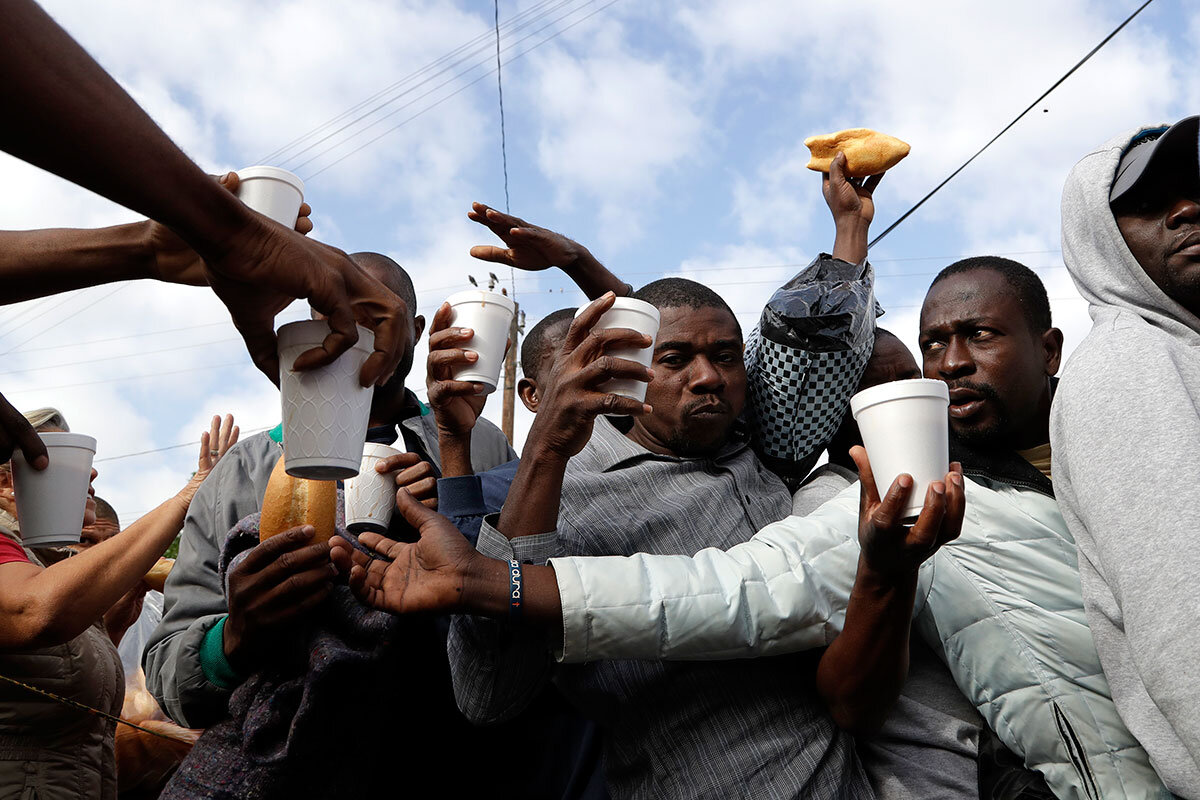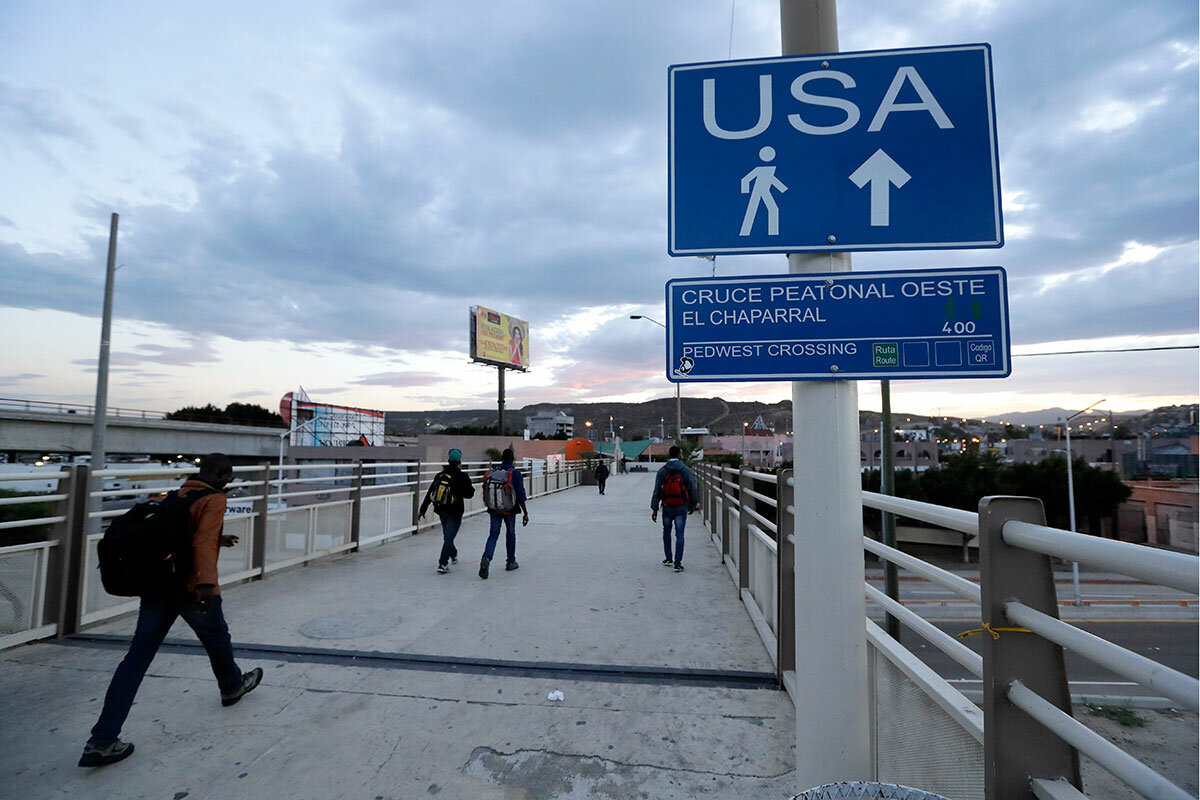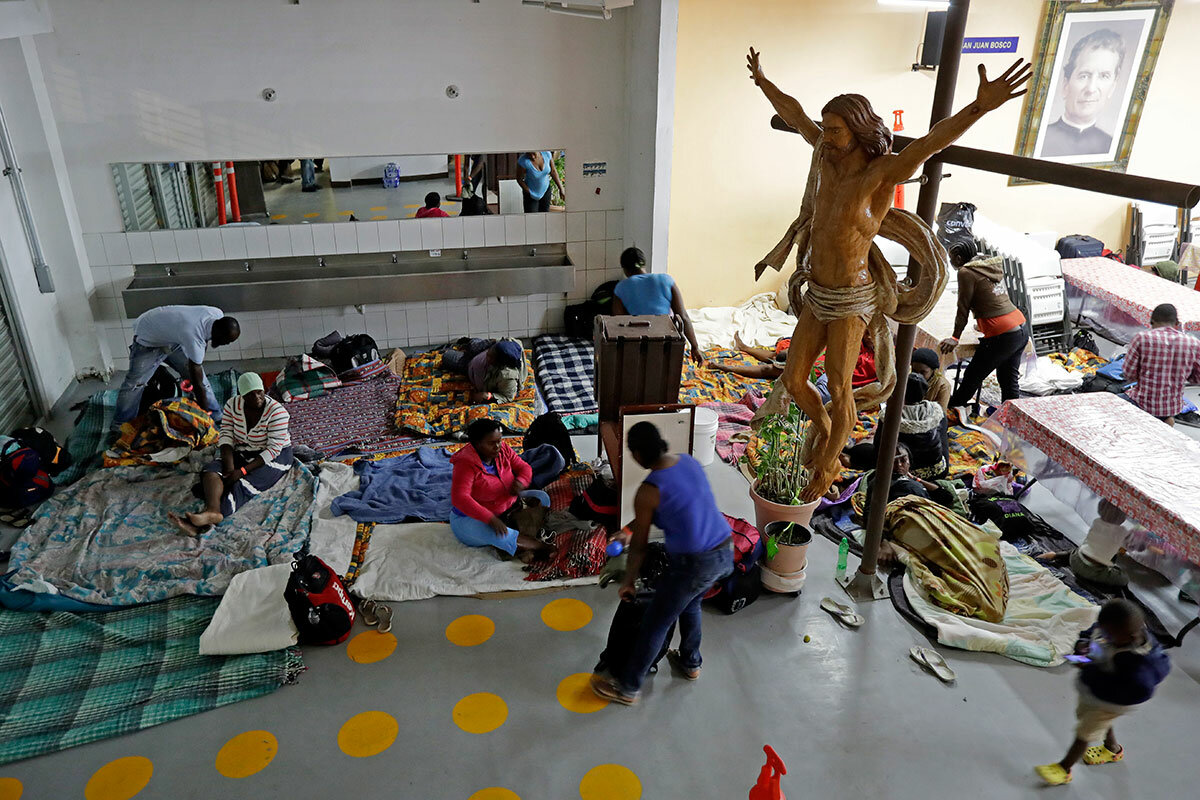Why, in Tijuana, a 'different kind of migrant' elicits help
Loading...
| Tijuana, Mexico
Dusk is falling on the trash-strewn dirt road that leads up to the Ambassadors of Jesus Church on a recent weekday afternoon. A few clusters of young men stomp their way up the path, past muddy hogs and a dog racing up and down a fence line.
The men’s dark skin and foreign tongue make it easy to identify them as outsiders, but strangers are nothing new here.
Each week,Ã˝Tijuana receives thousands of people fleeing violence or seeking opportunity, including Mexican deportees, Central American migrants, and refugees from around the globe. Its border with the United States is the most trafficked international crossing in the world. Ã˝
Many residents have grown accustomed to the long-term challenges that come with Tijuana's transitional nature, like deportees living in canals along the border, or migrants being recruited into criminal gangs. But a recent group of arrivals drew a new kind of attentionÃ˝‚Äì and actionÃ˝‚Äì from locals. Starting last spring, thousands of Haitians descended upon Tijuana on their way to the United States.
“People were arriving in the middle of the night, looking for help,” Pastor Gustavo Banda Aceves says, standing inside his church, The Ambassadors of Jesus, on the outskirts of the city. The periphery of the sanctuary is covered with mattresses, cots, and drying clothes, signs of the some 200 Haitian men, women, and children sheltered here. Last December, the space was filled with nearly 600 people.
“These are different kinds of migrants,” he says.
Outpouring of support
The perception that these migrants had distinctive needs drove an outpouring of support. Almost overnight, the number of Tijuana migrant shelters jumped from roughly 12 to more than 30. Locals fundraised to deliver clothes, food, and trainings to Haitians in need. Pastor Banda and his wife donated land in hopes of buildingÃ˝arguably Mexico‚Äôs first ‚ÄúLittle Haiti,‚Äù and local businessmen started passing by shelters, offering jobs specifically for Haitians.
That mobilization of support echoes a phenomenon seen around the globe, amid some of the worst refugee crises in decades. Yet along with the eager helping hands comes a glimpse of an unpleasant reality: Consciously or not, communities sometimes prioritize certain types of refugees or migrants over others, making the decision that some groups are more “worthy” of help and attention.
From Germany to Lebanon and Kenya to the United States,Ã˝how migrant or refugee groups are accepted or rejected can come down to language, how they look, religion, and cultural practices. Even the legal labels used to describe them ‚Äì whether refugee or migrant ‚Äì can play a part in how newcomers are welcomed by host communities.
Although the attention Haitians have garnered in Tijuana has at times been controversial – with some reprimanding locals for prioritizing them over fellow citizens – it has also sparked renewed interest in other groups in need here.
‚ÄúHaitians have felt like a priority,‚Äù says Jos√© Mar√≠a Garc√≠a Lara, who runs the shelter Movimiento Juventud 2000,Ã˝which for nearly 25 years has served deportees, homeless people, drug addicts, and migrants from around the globe.Ã˝Last year, the shelter set up a makeshift camp in a muddy lot next door to house the influx of Haitians.
But, Mr. Lara says, “many here have started standing up and saying, ‘Wait, we can’t forget our own.’ ”
'Unprecedented and unexpected'
The Haitians arriving here ‚Äì most of whom traveled overland from Brazil, where they‚Äôd fled after Haiti‚Äôs devastating 2010 earthquakeÃ˝‚ÄìÃ˝drew residents‚Äô attention for a number of reasons. Perhaps the most pressing was the United States‚Äô decision last September to resume deportations for Haitians entering the country without proper documentation,Ã˝who had previously been allowed to stay in the country for several years under a humanitarian parole policy.Ã˝The shift essentially left thousands of Haitians stranded in Mexico, where they hadn't planned to put down roots.Ã˝
They arrived poorly dressed for the weather, with young children in tow, after months-long journeys through up to eight countries. They experienced robberies, injuries, hunger, and, in some cases, witnessed deaths along the way. About 3,500 are still here.
‚ÄúThis was an unprecedented and unexpected migratory event,‚Äù Rodulfo Figueroa Pacheco,Ã˝a delegate from Mexico‚Äôs National Immigration Institute, told the Tijuana weekly magazine Zeta earlier this year.
Tijuana was once a central hub for migrants heading to the US. But starting in the mid-1990s, when border controls tightened, migrants moved east to cross via the desert, where they were less likely to be detected.Ã˝Today the city‚Äôs migratory population is mostly made up of deportees and people seeking asylum in the United States.Ã˝
But throughout Tijuana’s long history of receiving people in transit, “I’ve never seen this kind of reaction [to migrants in need] before,” says Soraya Vázquez, a human rights lawyer.
In part, the way Haitians physically stand out means it’s easier to identify the hardships they face: only about 1 percent of Mexicans are black. Central American migrants often come into the country without applying for transit visas, meaning they not only blend in physically in Mexico, but they’re invisible in the eyes of officials, as well. That can mean less public awareness and more abuses along their journey north, says Lara.
“You can’t confuse who [the Haitians] are or where they are from,” says Ms. Vázquez. “And their needs are clear. This has been an emergency that is impossible to ignore.”
Last September, V√°zquez helped found the Strategic Committee for Humanitarian Aid Tijuana, which connects the outpouring of donations for Haitians with shelters across the city. Even before the surge, there was limited government support for these hubs, making donations and volunteerism key.
'What do you lack?'
But amid the food, blankets, clothing, and know-your-rights training courses disseminated at shelters here, and the international media attention garnered by the Haitians‚Äô arrival, a hierarchy of perceived needs emerged, with Haitians at the top. Ã˝
Last December, a group of locals set up a table of food and drinks to give to Haitians in limbo. But when a Mexican got in line, a local taxi driver told the man he , PBS reports: “I told him, you’re Mexican. What do you lack?”
Criticism is also aimed at deportees from the US, caught between categories of “native-born” and “newcomer”: after years away, the return to Mexico hardly feels like coming home.
“We’re treated differently because of our time in the US,” says Sandra González, who was deported six years ago, after more than three decades in the US. The first few years back in Mexico, she was homeless, selling bubble gum on the street.
‚ÄúPeople don‚Äôt want to give deportees work,‚Äù she says, waiting in a doubled-back line of hungry men and women outside Tijuana‚Äôs Desayunador Salesiano ‚ÄúPadre Chava‚ÄùÃ˝soup kitchen on a recent Wednesday morning. Padre Chava serves breakfast for up to 1,200 people every day. ‚ÄúThey think you‚Äôve been in jail or you can‚Äôt be trusted,‚Äù Ms. Gonz√°lez says.
Commentary along those lines is found across the city – and on social media. But it’s not just those seeking help who might be criticized. Mr. Banda and his wife, for example, have been working to get the needed permits to build scores of single-family homes for Haitians near their Evangelical church. A comment on the church’s Facebook page reprimands the pastor for this work when there are kids in the streets and so many “people in misery” across the country. “Mexicans first,” the commenter chides.
‚ÄúThose out helping [Haitians here] are people who have helped or have wanted to help others in the past, but didn‚Äôt know how,‚Äù Banda says. When he‚Äôs criticized for aiding Haitians at the expense of Mexicans or others in need, he says it‚Äôs people ‚Äúseeing what my right hand is doing, but not the left.‚ÄùÃ˝
Powerful public impressions
Images of poverty and destruction from Haiti‚Äôs myriad earthquakes and public health crises over the past several decades no doubt accompany its citizens wherever they arrive, from Tijuana to Rio de Janeiro to Miami. But the way a refugee or migrant is treated doesn‚Äôt always come down to the situation he or she is fleeing. In 2015, certain nationalities, like Syrians and Iraqis, were allowed to migrate through the Balkans, while those deemed ‚Äúeconomic migrants‚Äù were turned away at the border.Ã˝Yet many of the countries those individuals were fleeing are not considered uniformly peaceful.
And outdated assumptions can influence public acceptance in other ways. In the United States, for instance, the conversation around migration tends to center on one specific group: Mexicans. Yet Mexican migration to the US has fallen in recent years, and , like Chinese and Indians.Ã˝
“Labels and perceptions play a big role in how [migrants and refugees] are treated, not only by a community, but by a government,” says Kevin Appleby, senior director of international migration policy at the Center for Migration Studies in New York.
Central Americans, for example, “are often not perceived as refugees because they aren’t fleeing a declared war, or they’re fleeing ‘bad guys,’ which feels more manageable,” he says. As a result, they’re often seen as economic migrants in Mexico and the US, and the dangers they are fleeing become less important from the public's point of view. In Europe, meanwhile, Syrians and Iraqis seen as escaping war are often welcomed in a way that Afghans, who may also be fleeing violence but are more commonly labeled economic migrants, are not.
‚ÄúOften the perception at the community level is that a refugee suffered something terrible and deserves a helping hand, and a migrant maybe is just there to take a piece of the pie,‚Äù says Amali Tower, founder of the NGO Climate Refugees,Ã˝who previously worked with the United Nations‚Äô refugee resettlement program.Ã˝
That makes who ‚Äúcounts‚Äù as a refugee hugely consequential.Ã˝Often, it‚Äôs governments who set the national conversation about a certain group, or make decisions about which nationalities are more worthy of refuge or aid, even if officials don‚Äôt talk about refugee hierarchies in those blunt terms, says J. Olaf Kleist, a senior researcher at the Institute for Migration and Intercultural Studies at the University of Osnabr√ºck in Germany.
‚ÄúThere can be political interests on top of stereotypes,‚Äù he says. Take Germany, for example, which has startedÃ˝ who do not qualify as refugees, despite concerns about their safety upon their return. That couldÃ˝be attributed to the fact that Germany is involved in the NATO mission in Afghanistan, Dr. Kleist says, and that by deeming Afghans unworthy of asylum, the country sends a message that Afghanistan ‚Äúis now a safe country.‚Äù
Renewed awareness
But an increase in interest and attention toward one specific group of refugees or migrants doesn‚Äôt always mean long-term discrimination against others, Kleist notes.Ã˝
‚ÄúThe Syrian refugee movement really stirred something in German society that other groups haven‚Äôt,‚Äù he says.Ã˝‚ÄúBut, after a couple of years, the people who started volunteering with Syrian refugees in mind got to know people from Afghanistan, East Africa,‚Äù he says. The kind of discrimination about who belongs here ‚Äúdisappeared once people got to know them. The differentiation between nationalities became much less.‚Äù
Something similar may be happening in Tijuana, according toÃ˝V√°zquez, from Tijuana‚Äôs Strategic Committee for Humanitarian Aid. In recent months, the group‚Äôs Facebook page was increasingly filled with posts about not just Haitians, but Central American migrants, asylum-seekers from other backgrounds, and deportees.
V√°zquezÃ˝says she is motivated by this renewed awareness of the needs of all types of migrants and refugees, even amid ongoing concerns that Haitians could take local jobs or burden public services.Ã˝
‚ÄúI tell them we can‚Äôt replicate the conversation going on in the US‚Äù about immigrants, many of them Mexican,Ã˝she says.Ã˝‚ÄúTijuana is a city of migrants. We need to help all groups in need.‚Äù







